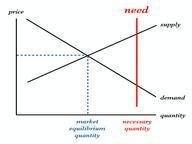Quiz Answer Key and Fun Facts
1. A huge part of modern economics is profit/utility maximization or cost minimization. This is achieved by differentiation of the function with respect to the variable in question, and setting this subsequent derivative equal to 0. What is this process also known as?
2. Assuming a firm has a total cost function defined as C(x)= 2x^2 - 6x + 5, what is the marginal cost of the firm?
3. If given the marginal cost of a firm, which process would one use to find the total cost?
4. Indifference curves can have many different formats. The most well known of these formats is the "well-behaved" utility curve, also known as the Cobb-Douglas utility function. Which of the following best represents a Cobb-Douglas utility function?
5. Optimization is sometimes limited to constraints, and therefore it is not always possible to find the strict maximum or minimum of a function, since the solution may not be feasible. Which multiplier is provides a strategy to dealing with constrained optimization?
6. In a Macroeconomic model, a social planner plans to achieve Pareto efficiency by finding a competitive equilibrium that is also on the Production Possibilities Frontier (PPF). This is done by equating the slope of the indifference curve (Marginal Rate of Substitution or MRS) to the slope of the PPF. What is this slope called?
7. Oligopolies are a reality in modern economics of the firm. Sequential oligopolies that specialize in quantity production are known as Stackelberg oligopolies, named after German economist Heinrich Freiherr von Stackelberg. Sequential games, such as Stackelberg competition, are solved by solving the leader's problem first.
8. Perfect competition is characterized by such a large number of firms competing that no firm can alter the market production or price significantly. As a result, firms become price takers. What is the formula characterizing the optimal long-run price level for firms in perfect competition?
9. In a two-period macroeconomic model, current period consumption is denoted by "C", and future period consumption is denoted by " C' ". How is the present value of future consumption denoted, knowing the interest rate is denoted by "r"?
10. This equation relates Marshallian (or utility maximization) demand to Hicksian (or expenditure minimization) demand. After a price change, it is used to divide the total effect of a good's demand change into substitution effect and income effect. What is it?
Source: Author
dim_dude
This quiz was reviewed by FunTrivia editor
stedman before going online.
Any errors found in FunTrivia content are routinely corrected through our feedback system.

